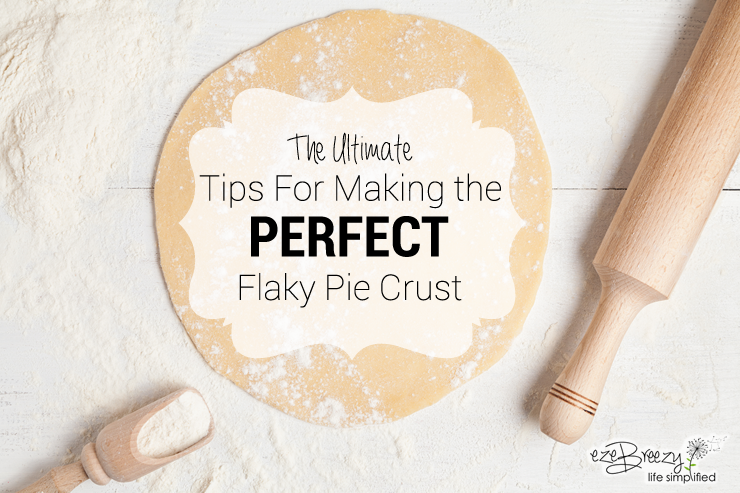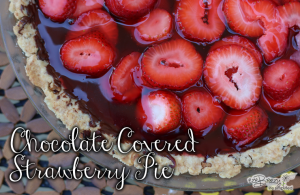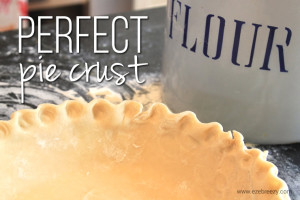There are just some things that can intimidate a person in the kitchen. Making pie dough from scratch seems to be one them. Well no longer! Here are the ultimate tips for making the perfect flaky pie crust.

I LOVE baking! LOVE! My 2 favorite things to bake are cakes and pies. Any kind of pie really – chocolate pie, lemon pie, strawberry pie! You name it, I love to make it {and eat it.} Over the past couple of years I have been experimenting with different pie crust recipes and trying to perfect my flaky pie crust making abilities!
Making a pie crust from scratch can certainly come with it’s challenges. Which is funny because the ingredients are simple enough… basically some type of flour, fat (usually butter, shortening or lard) and water or some other liquid (like vodka!). Shouldn’t be too hard, right? The tricky thing is that there are a few other factors that go into making the perfect flaky pie crust and I am here to let you in on a little secret and share some amazing life-changing {lol…well in the baking world anyway} tips and tricks that I have learn along my journey to making the perfect flaky pie crust. So let’s get started…
Keep everything cold! I can’t emphasize this enough. Here are a few tips to help things from getting too warm…
1. Put everything in the freezer for 5 minutes before I am going to use it: butter, pastry blender, water, measuring cups…everything!
2. Fill a gallon size bag with ice and lay it on the counter where you will be rolling out your dough for about 10 minutes or so.
3. Another tip to make sure your water is cold enough is to keep it in the freezer until ice crystals begin to form on top. You aren’t using much water so this will happen pretty quickly. If you are pressed for time, at least keep it in the freezer for 5 minutes with the rest of your kitchen tools.
4. Cut your butter into little cubes before chilling in the freezer. You can even use the large side of your grater and grate your butter before chilling in freezer.
5. If you find your hands are getting too warm, run them under cold water and pat dry on a towel or place them on the bag of ice you used to chill your counter.
6. Once you mix your flour and butter place this mixture back in the freezer for a few minutes before you start adding your water.
7. Once you have formed you the ball place the dough into the refrigerator. This is a necessary step because it allows the gluten to relax and prevent your crust from shrinking. If find that I need to roll the dough out twice but the crust doesn’t pull away from the edges of my pie plate.
Work the dough sparingly. Don’t be tempted to over-mix the dough it will make your crust tough.
1. When it’s time to incorporate the water into your flour/butter crumbs, don’t use the food processor. It’s too easy to overwork the dough. A food processor is fine to use when you are mixing your flour and fat. But once you have your crumbs – transfer them into a new bowl to finish.
2. To prevent over-mixing use your finger or a fork and add 1 tsp of water at a time. Be patient. It will all come together and this way you’ll find the perfect amount of water.
3. You want to see small bits of butter in your dough. Yes – they are supposed to be there – this is actually what gives you the flaky pie crust!
Don’t add too much liquid. Remember moist but not drenched.
1. Rule of thumb no matter what type of liquid you are using – add it in small amounts. After the first tablespoon of liquid I tend to add the balance 1 tsp at a time until I find the right amount. Recipes usually provide a specific amount of water (like 3 Tbsp) but factors such as your environment and even the moisture content of your flour will play a roll in how much water you actually need to add. So just a your liquid slowly and stop once the flour is moistened.
2. Use the pinch test to see if you have added the right amount of water. Pinch off a small piece of dough and squeeze it between you thumb and pointer finger. You want to dough to just stick together and still a have small dry cracks.
Rolling out your crust.
1. Removed dough ball from refrigerator and sit on counter for few minutes before starting to roll out your crust.
2. Be prepared to roll out twice. The first time you roll out your dough it is usually crumbly and uneven. It may even get large breaks through but don’t fret. This is normal! Just fold in the edges and form another ball. turn it over so that the smooth side, the bottom side, is now up and roll it out again.
It may take a little bit of practice to become comfortable making a pie crust recipe from scratch, but once you’ve mastered the technique, you will never go back.
Don’t be afraid to start making your crust from scratch. It may take a little practice to get your flaky pie crust but once you’ve mastered the technique, you’ll never use a box crust again. Plus, I am a huge believer that there is beauty in imperfection and that certainly applies when making a flaky pie crust. It adds charm and that personal touch. To me, that is a big part of baking. And at the end of the day, if you enjoyed doing it – that’s all that matters. Happy pie making!
If you have a pie crust making tip you’d like to share I’d LOVE to hear from you!
You might also like…

